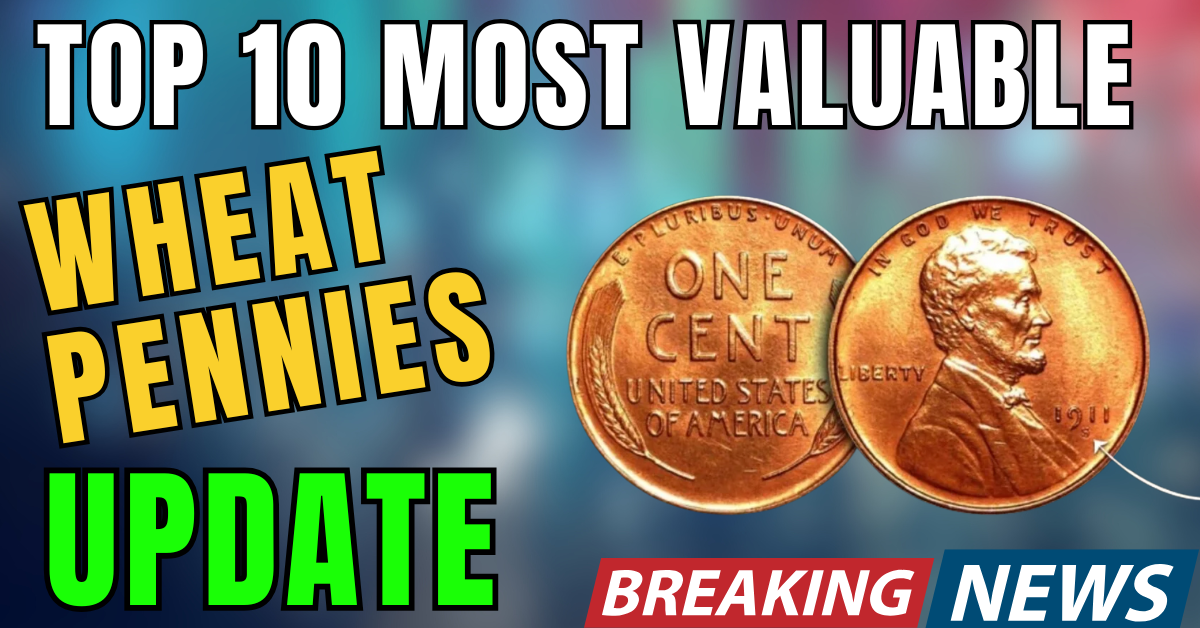Coin collectors and history enthusiasts, take note: Wheat Pennies, once a staple of everyday commerce, are now commanding staggering prices in the numismatic market. These vintage one-cent coins, minted between 1909 and 1958, are highly sought after for their rarity, historical significance, and unique errors. Today, we spotlight the top 10 most valuable Wheat Pennies that could be hiding in your pocket change or collection.
1. 1937 Wheat Penny (No Mint Mark)
Value: $720,000+ (Very Fine Condition)
Struck at the Philadelphia Mint, this coin’s sharp details and 95% copper composition make it a prize. With dwindling high-grade specimens, collectors are paying premiums for well-preserved examples.
2. 1941-D Wheat Penny (Extra Fine Condition)
Value: $650,000+
Minted in Denver during WWII, its historical context and pristine strikes drive demand. Extra Fine specimens with minimal wear fetch top dollar.
3. 1939 Wheat Penny (No Mint Mark, Excellent Condition)
Value: $630,000+
A Depression-era relic, its excellent-condition examples are rare due to heavy circulation. Toning and sharp wheat stalks elevate its appeal.
4. 1951-D Wheat Penny (Excellent Condition)
Value: 300,000–300,000–800,000
The Denver Mint’s post-war production saw high mintage, but uncirculated coins with original luster are scarce. Auction prices continue to climb.
5. 1958-D Wheat Penny (Very Good Condition)
Value: 200,000+The∗∗finalyear∗∗oftheWheatPennyseriesaddshistoricalweight.VeryGoodspecimensareincreasinglyhardtofind,withuncirculatedgradesreaching200,000+The∗∗finalyear∗∗oftheWheatPennyseriesaddshistoricalweight.VeryGoodspecimensareincreasinglyhardtofind,withuncirculatedgradesreaching900,000.
6. 1940 Wheat Penny (No Mint Mark, Fine Condition)
Value: $500,000+
A WWII-era coin with unique copper tones. Fine-condition examples are vanishing, spurring competitive bidding among collectors.
7. 1926 Wheat Penny (No Mint Mark, Extra Fine Condition)
Value: $1M+
Early Wheat Pennies in Extra Fine condition are rarities. This Philadelphia-minted issue boasts sharp details and deep patina, coveted by advanced collectors.
8. 1944 Wheat Penny (No Mint Mark, Circulated Condition)
Value: 300,000–300,000–800,000
Made from recycled WWII shell casings, its historical narrative and “dirty” original surfaces attract premiums. Uncirculated specimens can exceed $800,000.
9. 1925 Wheat Penny (No Mint Mark, Extra Fine Condition)
Value: $500,000+
Survivors in Extra Fine condition are exceptionally rare. Strong wheat ear details and Lincoln’s profile define its high-market appeal.
10. 1952-D Wheat Penny (Extra Fine Condition)
Value: 10–10–900,000
Denver’s output was vast, but top-grade coins with vibrant luster and minimal wear are vanishing. Error varieties (e.g., double dies) can skyrocket value.
Why the Surge in Demand?
- Scarcity: High-grade Wheat Pennies are disappearing into collections.
- Historical Value: Ties to WWII and the Great Depression amplify interest.
- Investment Potential: Prices have surged 20–30% in five years, with no slowdown.
Expert Tips for Collectors
- Authentication: Use PCGS or NGC grading to verify condition and authenticity.
- Preservation: Store coins in acid-free holders to prevent toning or damage.
- Market Trends: Track auction results (e.g., Heritage Auctions) for real-time pricing.
Conclusion
“These pennies were once worth a cent—now they’re worth fortunes,” says numismatist Dr. Emily Carter. “The key is condition. A single grade jump can multiply value tenfold.”
Whether you’re a seasoned collector or a novice, check your jars and albums. Your Wheat Penny might just be the next hidden treasure.
FAQ’s
1. What makes Wheat Pennies valuable?
A: Rarity, condition, mint marks, historical significance, and unique errors (e.g., double dies) drive value. High-grade specimens or coins tied to key events (like WWII) command the highest prices.
2. Which Wheat Penny is the rarest?
A: The 1926 No Mint Mark (Extra Fine condition) is among the rarest, with prices exceeding $1 million due to its low survival rate and early-series scarcity.
3. How can I tell if my Wheat Penny is valuable?
A: Check for:
- Mint marks (e.g., “D” for Denver).
- Condition (sharp details, minimal wear).
- Errors (double strikes, off-center designs).
- Year (key dates like 1944 or 1958-D).
4. Should I clean my Wheat Pennies?
A: Never. Cleaning reduces value by damaging patina and surfaces. Preserve them in acid-free holders instead.
5. Where can I sell my valuable Wheat Pennies?
A: Reputable auction houses (Heritage, Stack’s Bowers), certified dealers, or PCGS/NGC-graded coin marketplaces ensure fair prices and authenticity.

hi i m Herry broke i m blogger and content writer and cover news article and finance reated articles.

